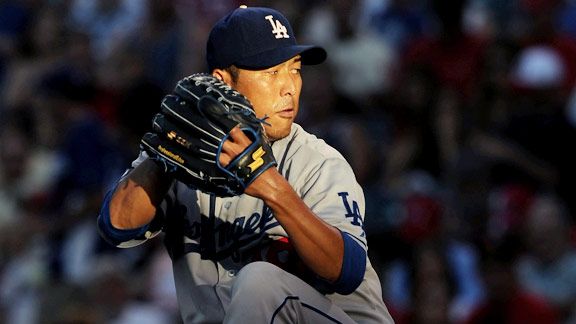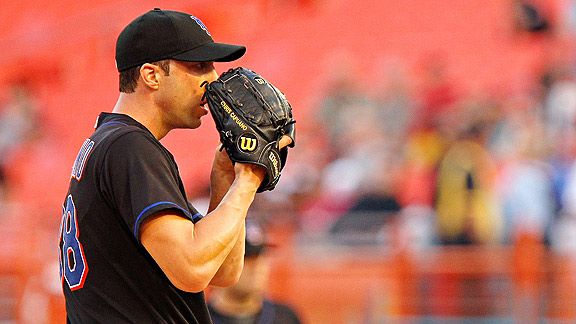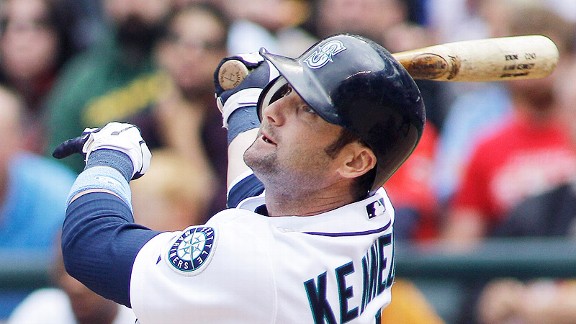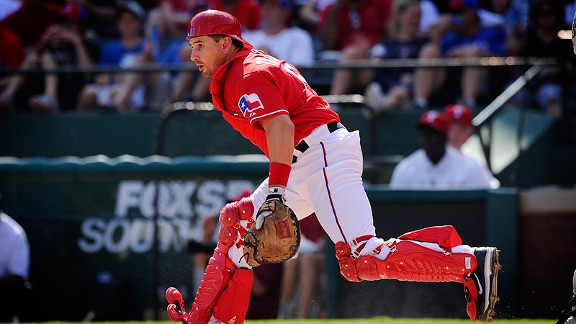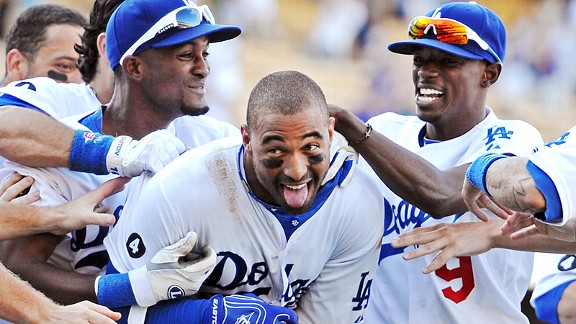At the end of the indispensable, forever-a-touchstone “Joe vs. the Volcano,” Joe (Tom Hanks) has survived depression, a diagnosis of a brain cloud and being exploded out of a live volcano. Life is suddenly looking good.
Except that Joe is on a liferaft made of steamer trunks, floating in the middle of the ocean at Poseidon’s mercy. He starts to worry again. Patricia (Meg Ryan), his love, can only laugh.
“It’s always going to be something with you, isn’t it Joe?” she remarks.
There will always be something with the Dodgers. There is no frying pan in this town whose escape route doesn’t lead to some flame, be it a campfire or a conflagration.
But the news today that the Dodgers are on the verge of signing Matt Kemp to a contract that locks up his rights until he is 35, in 2019, is Chapter Two in the rebirth of the franchise, following Frank McCourt’s agreement to sell the team this winter. The Dodgers might still be floating at sea, but they are floating in the right direction.
That the lame duck McCourt agreed to sign Kemp is newsworthy, though less surprising to me than others might find it. McCourt, essentially, is spending someone else’s money. As I wrote about Prince Fielder last month, the argument for committing to a big contract for a superstar is at least as strong as the argument against it — for whatever cost it adds to the bottom line, if it’s a smart signing it only enhances the worth of the franchise. That being said, McCourt could have been a roadblock to the signing but chose not to be. It’s a point in his favor on an eight-year-old scoresheet.
That hasn’t stopped people from at least acknowledging the potential downside of the deal. Anytime you offer the longest and richest deal in National League history, there’s going to be some risk. Some would point to the previous No. 1 deal in Dodger annals, the seven-year, $105 million contract for Kevin Brown, as evidence of this, though I concluded (in a blog post I can’t find right now) that when you combine the value Brown provided with what was received after he was traded to the Yankees, the Dodgers actually made out just fine on the deal.
So let’s look at Kemp’s contract: $160 million over eight years, we’re told. Some will get hung up over the question of whether Kemp will still be a $20 million player as he heads toward his 35th birthday in September 2019. But that’s the wrong way to eyeball things.
The only question that matters is whether Kemp will provide $160 million worth of value over the life of the contract, and that seems like a pretty safe bet.
Kemp will be 27 years old when the 2012 season begins. There’s an excellent chance he’ll be much more than a $20 million-a-year player next year and for at least few years after that, even if he can’t ever duplicate the marvels of his 2011 campaign.
To consider one evaulation, Fangraphs not only puts his value this year at $39 million, it assesses his 2009 season at $23.5 million. So even with a disappointing season mixed in ($1.6 million of value in 2010), Kemp has averaged $21.3 million in value the past three years — before hitting his prime. And that doesn’t even include one thing you can’t put a price on right now: the comfort of knowing that this signing means the Dodgers are back in business.
In other words, Kemp might earn the entire cost of his contract in the next five or six years — he might be a bargain over that time — and everything after that will be gravy on the cake. Furthermore, though Kemp will be older at the end of the decade, he won’t exactly be ancient. He’ll be younger, for example, than Manny Ramirez was before Ramirez first wore a Dodger uniform.
Now, if and when Kemp is in decline in 2019, few people may remember to look at his contract the way I’m advising. They’ll compare his 2019 performance with his 2019 salary and come to a 2019 conclusion that he is underperforming. But major league baseball does not pay players strictly according to performance — they are underpaid some years, as Kemp was in 2011, and they will be overpaid in others. All a franchise can do is make the best decision possible regarding the entire life of the contract.
Over the next eight years, I expect to see different sides of Kemp. I expect to see the all-out, hold-nothing-back player we saw in 2011, but undeniably, the contract is also an invitation to shift into cruise control from time to time — and honestly, who among us wouldn’t respond to that Evite here and there? The Dodgers are signing a human, not a robot. We also, for the first time, will at some point probably see a Kemp that gets hurt.
Contracts like these aren’t about moments, however. They are about the big picture. And with McCourt exiting to the left, and Kemp (and, I expect, Clayton Kershaw) remaining center stage, the big picture looks the rosiest it has for Los Angeles since before that day in October 2009, when the McCourt family business dumped a big ink blot on it. And Kemp himself must realize this. Though 160 million birds in the hand are nothing to be dismissed, it’s safe to say that Kemp might be leaving a few million more birds in the bush.
Yes, the Dodgers are still out to sea, but the wind is back at their back. We might even look back at 2011 to find, believe it or not, that this was the starting point for a Dodger decade.

